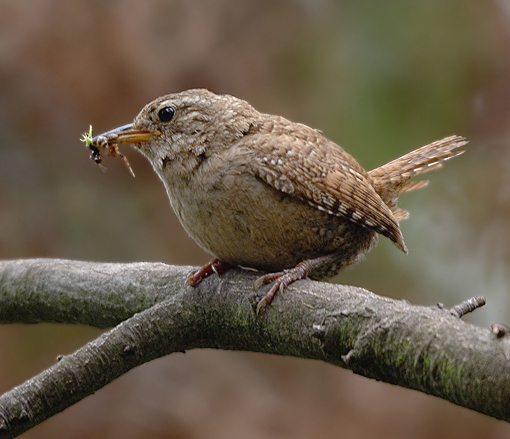- Wren
Taxobox
name = Wrens

image_width = 240px
image_caption =Winter Wren ("Troglodytes troglodytes")
regnum =Animal ia
phylum = Chordata
classis = Aves
ordo =Passeriformes
subordo =Passeri
familia = "Troglodytidae"
familia_authority = Swainson,1832
subdivision_ranks = Genera
subdivision = "Odontorchilus "
"Salpinctes "
"Microcerculus "
"Campylorhynchus "
"Catherpes "
"Hylorchilus "
"Thryomanes "
"Thryothorus "
"Cinnycerthia "
"Cantorchilus "
"Thryophilus "
"Pheugopedius "
"Cyphorhinus "
"Uropsila "
"Thryorchilus "
"Henicorhina "
"Troglodytes"
"Cistothorus "
"Ferminia "The wrens are
passerine birds in the mainlyNew World family Troglodytidae. There are about 80species of true wrens in about 20 genera, though the name is also ascribed to other unrelated birds throughout the world. Only one species occurs in theOld World , where it is commonly known simply as the "Wren"; it is calledWinter Wren in North America.The 27
Australasia n "wren" species in the familyMaluridae are unrelated, as are theNew Zealand wren s in the family Acanthisittidae, the antwrens in the familyThamnophilidae , and the wren-babblers of the familyTimaliidae .Description
Troglodyte means "cave-dweller", and the wrens get their scientific name from the tendency of some species to forage in dark crevices. They are mainly small and inconspicuous, except for their loud and often complex songs. These birds have short wings and a thin down-turned bill. Several species often hold their tails upright. All areinsectivorous , though some also feed on vegetable matter, and the larger—sometimes notably bold—species in of the genus "Campylorhynchus " will take small vertebrates (e.g.lizards ).They range in size from the
White-bellied Wren , which averages under 10 centimetres (4 in) and convert|9|g|1, to theGiant Wren , which averages about 22 cm (9 in) and 50 g (2 oz). The dominating colours are grey, brown, black and white, and most species show some barring, especially to tail and/or wings.The various species occur in a wide range of habitats, ranging from dry, sparsely wooded country to rainforest. The vast majority are found at low levels, but some members of the genus "
Campylorhynchus " and both members of the genus "Odontorchilus " are commonly found at canopy height. A few species, notably the Winter Wren and theHouse Wren , are often associated with humans. Most species are non-migratory, remaining in Central and South America all year round, but the few temperate species typically migrate to warmer climes in winter. Wrens build dome-shaped nests, and may be either monogamous or polygamous, depending on species.cite book |editor=Forshaw, Joseph|author= Perrins, C.|year=1991|title=Encyclopaedia of Animals: Birds|publisher= Merehurst Press|location=London|pages= 190|isbn= 1-85391-186-0]Genus list in taxonomic order
Revised following Martínez Gómez "et al." (2005) and Mann "et al." (2006). The taxonomy of some groups is highly complex, and future species-level splits are likely. Additionally, undescribed
taxa are known to exist. TheBlack-capped Donacobius is an enigmatic species traditionally placed with the wrens more for lack of a more apparent alternative and/or thorough study. It was more recently determined to be most likely closer to certain "warblers ", possibly the newly-establishedMegaluridae , and might constitute amonotypic family (Alström "et al." 2006).FAMILY: TROGLODYTIDAE
*Genus "Odontorchilus "
**Grey-mantled Wren ("Odontorchilus branickii")
**Tooth-billed Wren ("Odontorchilus cinereus")*Genus "
Salpinctes "
**Rock Wren ("Salpinctes obsoletus")*Genus "
Microcerculus "
**Flutist Wren ("Microcerculus ustulatus")
**Southern Nightingale-Wren ("Microcerculus marginatus")
**Northern Nightingale-Wren ("Microcerculus philomela")
**Wing-banded Wren ("Microcerculus bambla")*Genus "
Catherpes "
**Canyon Wren ("Catherpes mexicanus")*Genus "
Hylorchilus "
**Nava's Wren ("Hylorchilus navai")
**Slender-billed Wren ("Hylorchilus sumichrasti")*Genus "
Campylorhynchus "
**Band-backed Wren ("Campylorhynchus zonatus")
**Bicolored Wren ("Campylorhynchus griseus")
**Boucard's Wren ("Campylorhynchus jocosus")
**Cactus Wren ("Campylorhynchus brunneicapillus")
**Fasciated Wren ("Campylorhynchus fasciatus")
**Giant Wren ("Campylorhynchus chiapensis")
**Gray-barred Wren ("Campylorhynchus megalopterus")
**Rufous-naped Wren ("Campylorhynchus rufinucha")
**Spotted Wren ("Campylorhynchus gularis")
**Stripe-backed Wren ("Campylorhynchus nuchalis")
**Thrush-like Wren ("Campylorhynchus turdinus")
**White-headed Wren ("Campylorhynchus albobrunneus")
**Yucatan Wren ("Campylorhynchus yucatanicus")*Genus "
Thryomanes "
**Bewick's Wren ("Thryomanes bewickii")*Genus "
Thryothorus "
**Carolina Wren ("Thryothorus ludovicianus")
*** White-browed Wren ("Thryothorus (ludovicianus) albinucha")*Genus "
Cinnycerthia "
**Fulvous Wren ("Cinnycerthia fulva")
**Peruvian Wren ("Cinnycerthia peruana")
**Rufous Wren ("Cinnycerthia unirufa")
**Sharpe's Wren ("Cinnycerthia olivascens")*Genus "
Cantorchilus " (formerly included in "Thryothorus")
**Stripe-breasted Wren ("Cantorchilus thoracicus")
**Stripe-throated Wren ("Cantorchilus leucopogon")
**Plain Wren ("Cantorchilus modestus")
*** Canebrake Wren ("Cantorchilus (modestus) zeledoni")
**Riverside Wren ("Cantorchilus semibadius")
**Bay Wren ("Cantorchilus nigricapillus")
**Superciliated Wren ("Cantorchilus superciliaris")
**Buff-breasted Wren ("Cantorchilus leucotis") (probably notmonophyletic )
**Fawn-breasted Wren ("Cantorchilus guarayanus")
**Long-billed Wren ("Cantorchilus longirostris")*Genus "
Thryophilus " (formerly included in "Thryothorus")
**Gray Wren ("Thryophilus griseus") (placement in genus requires confirmation)
**Rufous-and-white Wren ("Thryophilus rufalbus")
**Niceforo's Wren ("Thryophilus nicefori")
**Sinaloa Wren ("Thryophilus sinaloa")
**Banded Wren ("Thryophilus pleurostictus")*Genus "
Pheugopedius " (formerly included in "Thryothorus")
**Moustached Wren ("Pheugopedius genibarbis")
**Coraya Wren ("Pheugopedius coraya")
**Whiskered Wren ("Pheugopedius mystacalis")
**Plain-tailed Wren ("Pheugopedius euophrys")
**Black-bellied Wren ("Pheugopedius fasciatoventris")
**Black-throated Wren ("Pheugopedius atrogularis")
**Sooty-headed Wren ("Pheugopedius spadix")
**Speckle-breasted Wren ("Pheugopedius sclateri")
**Happy Wren ("Pheugopedius felix")
**Inca Wren ("Pheugopedius eisenmanni")
**Rufous-breasted Wren ("Pheugopedius rutilus")
**Spot-breasted Wren ("Pheugopedius maculipectus")*Genus "
Cyphorhinus "
**Chestnut-breasted Wren ("Cyphorhinus thoracicus")
**Musician Wren ("Cyphorhinus aradus")
**Song Wren ("Cyphorhinus phaeocephalus")*Genus "
Uropsila "
**White-bellied Wren ("Uropsila leucogastra")*Genus "
Henicorhina " - wood-wrens
**Bar-winged Wood-Wren ("Henicorhina leucoptera")
**Gray-breasted Wood-Wren ("Henicorhina leucophrys")
**White-breasted Wood-Wren ("Henicorhina leucosticta")
**Munchique Wood-Wren , ("Henicorhina negreti")*Genus "
Thryorchilus "
**Timberline Wren ("Thryorchilus browni")*Genus "Troglodytes" (10-15 species, depending on
taxonomy ; includes "Nannus" which may be distinct however)*Genus "
Cistothorus "
**Apolinar's Wren ("Cistothorus apolinari")
**Marsh Wren ("Cistothorus palustris")
**Paramo Wren ("Cistothorus meridae")
**Sedge Wren ("Cistothorus platensis")*Genus "
Ferminia "
**Zapata Wren ("Ferminia cerverai")References
* Alström, Per; Ericson, Per G.P.; Olsson, Urban & Sundberg, Per (2006): Phylogeny and classification of the avian superfamily Sylvioidea. "Molecular Phylogenetics and Evolution" 38(2): 381–397. doi|10.1016/j.ympev.2005.05.015
* Mann, Nigel I.; Barker, F. Keith; Graves, Jeff A.; Dingess-Mann, Kimberly A. & Slater, Peter J. B. (2006): Molecular data delineate four genera of "Thryothorus" wrens. "Molecular Phylogenetics and Evolution" 40: 750–759. DOI|10.1016/j.ympev.2006.04.014 (HTML abstract)
* Martínez Gómez, Juan E.; Barber, Bruian R. & Peterson, A. Townsend (2005): Phylogenetic position and generic placement of the Socorro Wren ("Thryomanes sissonii"). "Auk" 122(1): 50–56. [English with Spanish abstract] DOI:10.1642/0004-8038(2005)122 [0050:PPAGPO] 2.0.CO;2 [http://www.specifysoftware.org/Informatics/bios/biostownpeterson/MBP_A_2005.pdf PDF fulltext]
External links
* [http://ibc.hbw.com/ibc/phtml/familia.phtml?idFamilia=134 Wren videos] on the Internet Bird Collection
Wikimedia Foundation. 2010.
